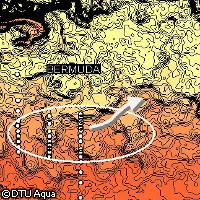Eel larvae follow faster, shorter route to Europe
Do European eel (Anguilla anguilla) larvae follow a westerly drift route into the Gulf Stream at the start of their trip? No they don't, a new international study shows. The results of this study on bio-physical linkages in the Sargasso Sea point to an alternative, shorter route for larval drift towards Europe. The research is presented in the Proceedings of the Royal Society B, Biological Sciences. Eel populations in Europe and the US are shrinking dramatically. Led by the Technical University of Denmark, this latest study sheds light on the early oceanic phase of the eel's life cycle, as well as the conditions for larval growth and feeding patterns. The results obtained by the Danish Galathea 3 Expedition to the eel's spawning sites in the Sargasso Sea, located in the middle of the North Atlantic Ocean, indicate how significant a role the climate plays on oceanic processes when determining the conditions for the eel's early life, as well as for assessing the shrinking population of these mysterious creatures. 'Our studies in the Sargasso Sea demonstrate a significant relationship between the physical and biological conditions in the area,' explained Peter Munk from the National Institute of Aquatic Resources, Technical University of Denmark (DTU Aqua). 'A front established where warm tropical waters meet colder North Atlantic water has a key role in the larval life of eel.' The scientists found that the front keeps eel larvae inside a zone that not only has better feeding conditions but also impacts their drift towards the continent. According to the team, most people believe that European eel initially follow a westerly drift route from the spawning site and then drift with the Gulf Stream, a warm ocean current that flows from the Gulf of Mexico northward through the Atlantic Ocean. However, the research points to the existence of a strong link between the distribution of larvae and the fronts in the area. The scientists contend that the front between the warm and cold waters triggers a current that moves eastward. So the larvae could 'use this subtropical counter current' as another option; it's a faster and shorter way to move towards Europe. In a related research development, another study from the Galathea 3 Expedition, published in the journal Biology Letters, provides insight into the diet of eel larvae, specifically the feeding habits of very small eel larvae. In the past, researchers thought that the eel's passage to the Sargasso Sea was connected to the feeding opportunities in the area for the super tiny eel. By using DNA (deoxyribonucleic acid) barcoding, the scientists could identify the different plankton organisms found in the otherwise unidentifiable gut contents of the larvae. Their research reveals that eel larvae enjoy a smorgasbord of sea creatures while tiny jellyfish are among their favourite titbits. 'DNA barcoding of gut contents of 61 genetically identified A. anguilla larvae caught in the Sargasso Sea showed that even the smallest larvae feed on a striking variety of plankton organisms, and that gelatinous zooplankton is of fundamental dietary importance,' the authors write. 'Hence, the specific plankton composition seems essential for eel larval feeding and growth, suggesting a linkage between eel survival and regional plankton productivity.' The scientists of this study note that their findings could be used to foster work on artificial reproduction and the rearing of the European eel. Also contributing to both these studies were scientists from Austria, Belgium, Canada and Sweden.
Countries
Austria, Belgium, Canada, Denmark, Sweden



